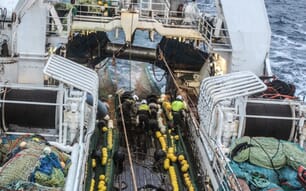On commission from the Norwegian Fishery and Aquaculture Industry Research Fund (FHF) and the Norwegian Fishermen's Sales Organisation, Nofima, together with longline fishing vessel "Sigurdur B", carried out trials with hand baited longlines in the Malangen fishing ground in Troms in November and December.
Checking bait in Iceland
Scientists from Nofima Market have for quite some time been working on market-based harvesting strategies. They were presented the optimal longline bait on a recent visit to Iceland together with longline fisherman Bjarni Sigurdsson (owner of the fishing vessel "Sigurdur B). This bait apparently gives higher catch rates of haddock and a higher proportion of larger haddock. However, the effects were not scientifically documented. Viewed in relation to the low utilisation of haddock quotas and the reputation for quality of fish caught by longline vessels, scientists from Nofima Market decided to collaborate with the longline fisherman. They wanted to study whether this bait could contribute to better profitability for traditional longline fishing in Norway.
The bait is today produced by Icelandic company Bernskan ehf, in Sudavik in North-western Iceland. The bait that was tested is produced from mackerel with stomach content of copepods. The production involves frozen mackerel being pulverised and formed into 10 gram units subjected to high pressure. The bait is then packed into cellulose bags. Other fatty fish has also been tested in Iceland with partially good results.

Several advantages
The bagged bait has other advantages too. Fishermen do not have to cut the bait, it is clean and the baiting process is quicker and easier than with traditional bait. Setting of the longlines also goes more smoothly. The bait does not stick to the paper in the sea and the proportion of tangles and hooks that get caught in each other reduces. Another advantage is that birds show no interest in the bags.
Increased profitability
The bagged bait is more expensive that traditional bait, but improved catch rates contribute to increased profitability. Bagged bait with the pulverised copepod Calaus finmarchicusmixed in gives better profitability than the Pacific Ocean species saury, which is normally used as bait, but is less profitable then using traditional mackerel bait.
Much larger haddock
Longline catches in the Malangen fishing ground at this time of the year are dominated by haddock. The trials so far indicate that the bagged bait gives catches with more and larger haddock. In comparison with saury, the bagged bait catches increase the catch rates (kg/hook) of haddock by 15 percent. The increase over mackerel bait is 31 percent.
- When we compare saury and mackerel with bagged bait with copepod Calaus finmarchicus added, the increase is 19 percent and five percent respectively, says Head of Project Edgar Henriksen at Nofima Market.
Different result for cod
The catch rates for cod and other fish species appear to drop with the use of bagged bait. Overall the effect, measured in catch value, is positive for the bagged bait when compared with saury (18 percent increase) and mackerel (10 percent increase). When copepod Calaus finmarchicus is added to the bagged bait, the effect is still positive in comparison with bait from saury, but negative with respect to bait from mackerel.
Fishermen interested
The longline fishermen have taken notice of the positive results. However, considerable work remains until the final conclusions can be drawn. The registrations will continue for another two months. The trials have been greeted favourably by other longline fishermen fishing in the Malangen fishing ground. They are also making the necessary registrations so their catch details can form the basis for comparisons.
The project is being administered by the Norwegian Fishermen's Sales Organisation on behalf of FHF, and is being implemented by Nofima Market. Both the Norwegian Fishermen?s Sales Organisation and FHF are contributing to the financing of the project. For more information, see the project description on the FHF website (in Norwegian language only).



